Systematic Review and Meta-analysis: Athlete Leadership and Cohesion
Researchers have shed light on the shared nature of athlete leadership, whereby responsibilities are shared amongst teammates who lead each other toward the achievement of team goals (Cotterill & Fransen, 2016; Loughead et al., 2019). Researchers using quantitative methodologies have primarily employed cross-sectional designs, relying heavily on the Leadership Scale for Sports (LSS; Chelladurai & Saleh, 1980) and the Differentiated Transformational Leadership Inventory (DTLI; Callow et al., 2009) to measure athlete leadership behaviours. While many correlates have been examined in relation to athlete leadership, cohesion has been the most examined (Loughead, 2017). The purpose of the current study was to synthesize and meta-analyze the currently available research examining the relationship between athlete leadership behaviours and cohesion. Data was collected from various databases, including Scopus, Web of Science, SPORTDiscus, PsycINFO, and Google Scholar. In total, 13 studies (n = 13; k = 18; N = 2368) reporting 72 effect sizes met the inclusion criteria. Analysis was carried out using RStudio and the Metafor package, revealing a positive link between athlete leadership behaviours and team cohesion, indicating that stronger athlete leadership is linked to higher perceptions of team unity and bonding. In particular, the main effects were larger for task cohesion than for social cohesion. Moderation analyses indicated that male and female athletes perceive the behaviours displayed by their athlete leaders in similar ways. These findings will aid coaches and practitioners to tailor leadership interventions to the needs of their team.



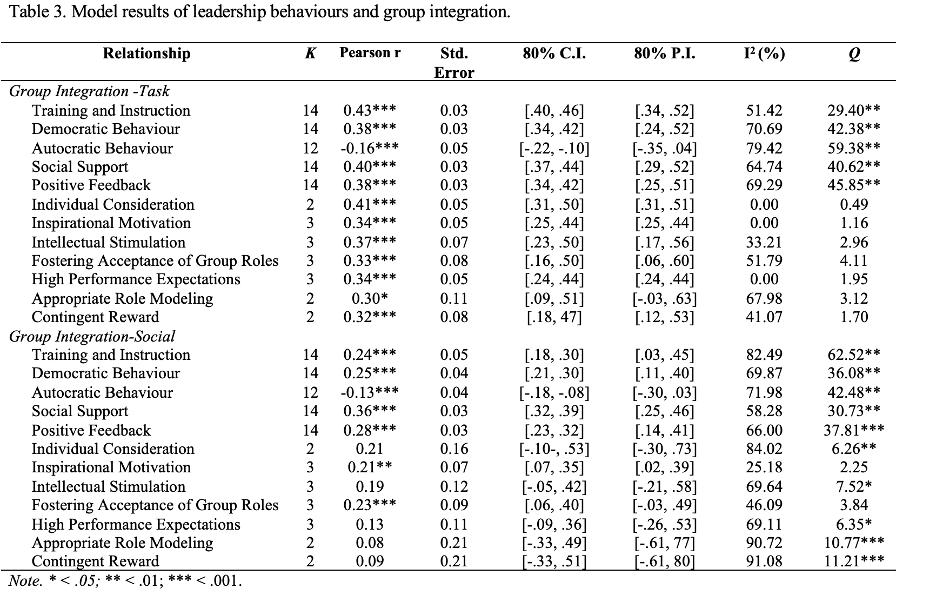



Psychometric Validation: Leadership Scale for Sports & Differentiated Transformational Leadership Inventory
Cross-sectional research in the field of athlete leadership has primarily relied on questionnaires modified from other fields, such as coaching and business (Loughead, 2017). This study evaluated the factorial and concurrent validity of the athlete leader version of the Leadership Scale for Sports (LSS; Chelladurai & Saleh, 1980) and the Differentiated Transformational Leadership Inventory (DTLI; Callow et al., 2009) using independent clusters model confirmatory factor analyses (ICM-CFA) and exploratory structural equation models (ESEM). Results indicated that ESEM first-order factorial models fit the data better than ICM-CFA first-order models for both the LSS (CFI = 0.93; TLI = 0.90; RMSEA = 0.04; SRMR = 0.03) and DTLI (CFI = 0.99; TLI = 0.98; RMSEA = 0.03; SRMR = 0.02). These findings suggest that using less restrictive measurement models, such as ESEM, may better reflect the complexity of the relationship between athlete leadership behaviours and other constructs (Asparouhov & Muthén, 2009). Regarding concurrent validity, the LSS behaviours accounted for 44% of the total variance in team cohesion (R2 = 0.44; p < 0.05) while the DTLI behaviours accounted for 56% of the total variance in team cohesion (R2 = 0.56; p < 0.05), providing support for the concurrent validity of the ESEM first-order factorial models. These findings suggest that using less restrictive measurement models, such as ESEM, may better reflect the complexity of the relationship between athlete leadership behaviours and other constructs.



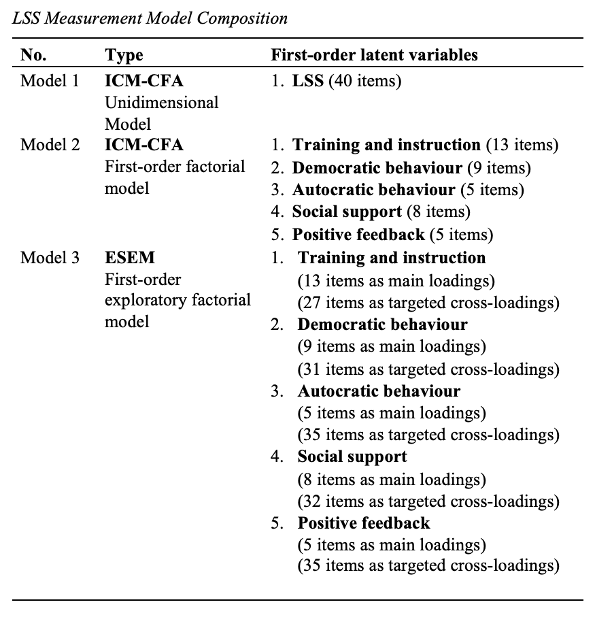

Creation of a Short Athlete Leadership Questionnaire
The project aimed to combine the LSS and DTLI items into a short athlete leadership questionnaire to reduce participant burden and improve measurement accuracy. Starting with an exploratory factor analysis using 200 data points, I utilized JASP to uncover the factor structure among the merged 67 items. Eigenvalues exceeding 1 guided the process, and Oblimin rotation was employed under the Principle Axis Factoring estimation method. Seven factors and 28 items were identified in the final model. Next, a comparison was made between independent-clusters-confirmatory-factor-analysis (ICM-CFA) and exploratory structural equation models (ESEM) using a dataset of 480 data points. Employing the robust full information robust maximum likelihood estimator (MLR) in Mplus, the ESEM proved to be a better fit, effectively capturing complex relationships within the data. This model’s strong fit confirmed its accuracy and usefulness as a concise athlete leadership questionnaire.
The short questionnaire provides a useful tool for assessing athlete leadership, which can be useful for coaches and practitioners who wish to conduct interventions aimed at improving leadership skills among athletes. The study also highlights the importance of specific leadership behaviours, such as democratic behaviour, training and instruction, and appropriate role model in fostering team cohesion. Further, the shorter length of the questionnaire may prove less burdensome for participants and decrease the chance of inaccurate responses (Famodu et al., 2018). Shortened validated scales not only decreases participants’ response time but also allows researchers to examine additional dependent and independent variables (Famodu et al., 2018).


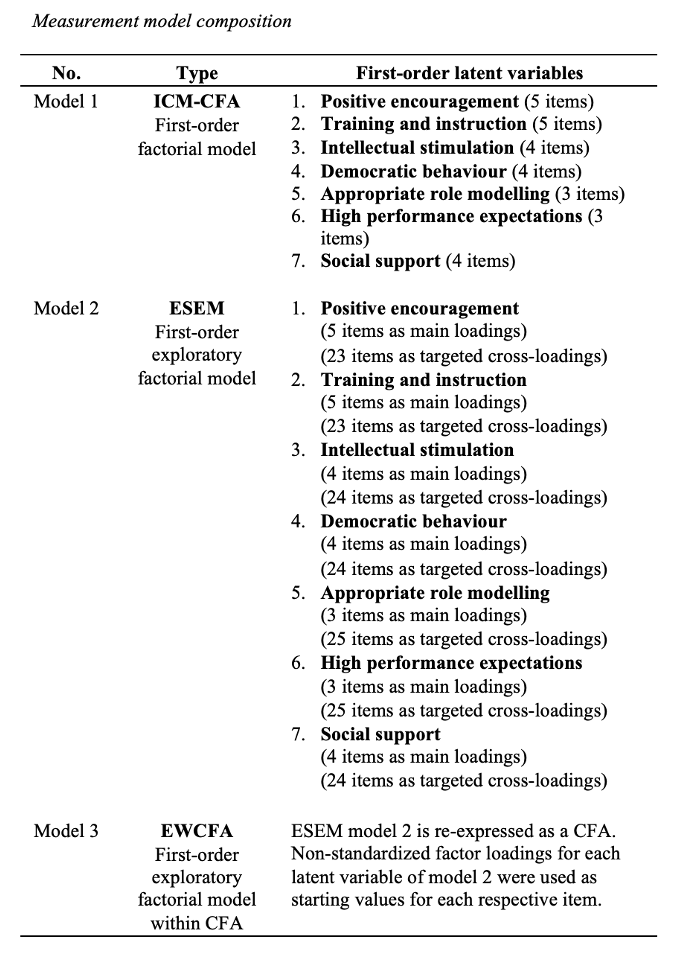

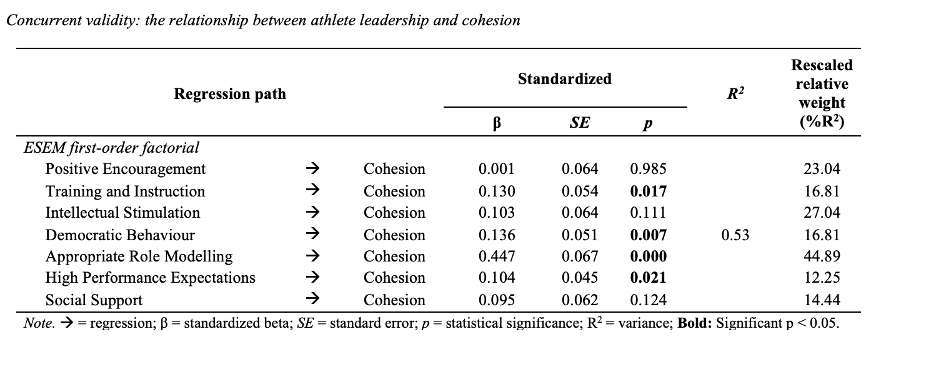

Athlete Leadership Development Intervention
This project aimed to implement athlete leadership development workshops during the 2017-18 hockey season, involving a 14-player team in the Bluewater Hockey League. Employing a mixed-methods research approach, the project evaluated the impact of the intervention on team cohesion and collective efficacy. The quantitative analysis involved pre- and post-intervention questionnaires, employing the Leadership Scale for Sports (LSS), Differentiated Transformational Leadership Inventory (DTLI), Youth Sport Environment Questionnaire (YSEQ), and Collective Efficacy Questionnaire for Sports (CEQS). Utilizing frequentist paired samples t-tests and Bayesian paired-samples t-tests in SPSS and JASP, respectively, the quantitative results indicated no statistically significant increase in cohesion and collective efficacy over the hockey season. Nevertheless, Bayesian analyses suggested that the athlete leadership intervention may have contributed to maintaining these levels. In parallel, a qualitative component involved a focused group of four team members. Hierarchical content analysis revealed themes including cohesion, communication dynamics, shared leadership attributes, and programmatic benefits. These themes collectively highlighted the intervention’s efficacy, particularly in enhancing the team’s resilience during a challenging season characterized by suboptimal performance metrics (3–26-5 record, 16.18% winning percentage).






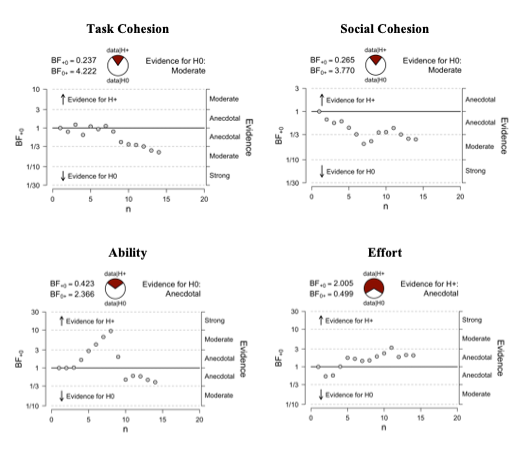
Bibliometric Analysis of the Athlete Leadership Literature
The purpose of this project was to conduct a bibliometric analysis of the athlete leadership literature, utilizing co-citation and citation analyses to discern prominent trends within the field. The co-citation analysis sought to uncover the intellectual landscape of athlete leadership literature from an author’s perspective, while the citation analysis aimed to identify influential publications and bridge articles that establish connections between diverse topics. The study sourced data from multiple databases: Scopus, Web of Science, SPORTDiscus, and Google Scholar. A total of 446 documents were collected and organized using Zotero, an open-access reference management tool, with the elimination of duplicate entries. Following this refinement process, 242 documents were selected for analysis. The data was exported to a CSV file and then analyzed in RStudio using the Bibliometrix package to identify key publications and frequently cited authors. The outcomes of the bibliometric analyses were visualized using VOSviewer, a specialized bibliometric software tool. The findings highlighted two distinct types of researchers within the athlete leadership literature: those concentrating on leader behaviours and those focusing on social identity.


Examining the Impact of Trust of Athlete Leadership
This project aimed to examine trust within the framework of athlete leadership. A questionnaire package was administered electronically to 121 athletes via FluidSurvey. Addressing missing data, the sample average was employed for substitution, and data was categorized in Excel based on demographic factors, leadership status, trust antecedents (benevolence, ability, integrity, justice), and trust in an athlete leader. Utilizing SPSS AMOS, a multiple regression analysis was conducted to explore the association between trust antecedents and trust in a peer athlete leader. The findings revealed that the combined trust antecedents (benevolence, ability, integrity, justice) accounted for 71% of the variance in trust in an athlete leader. Specifically, a leader’s ability (β = .18, p < .05) and benevolence (β = .67, p < .05) significantly influenced higher levels of trust in the leader.
From a leadership development perspective, sport psychology consultants should focus on the development of benevolence and ability in order to foster athlete leadership behaviours and create a trustworthy team environment. Teaching skills in which the leader exhibits behaviours that show care, support, and willingness to do good for teammates without expecting similar acts in reciprocity can create an environment in which trust is present amongst group members.


Coach Willingness to Use Sport Psychology Services

Investigating Player Approach Speed in National Hockey League (NHL) Shootouts
